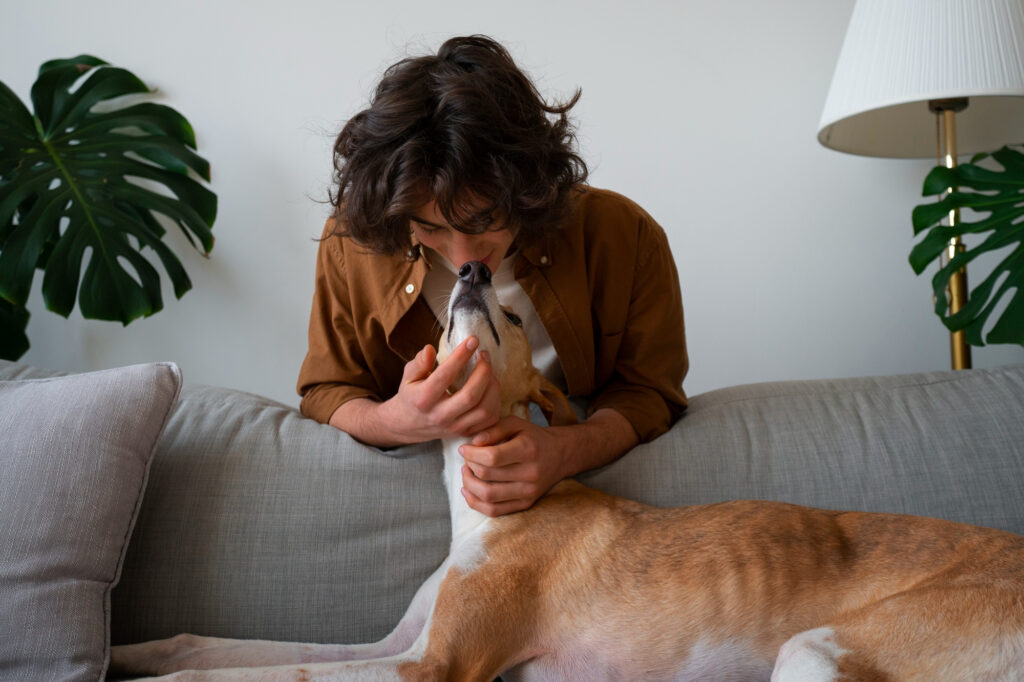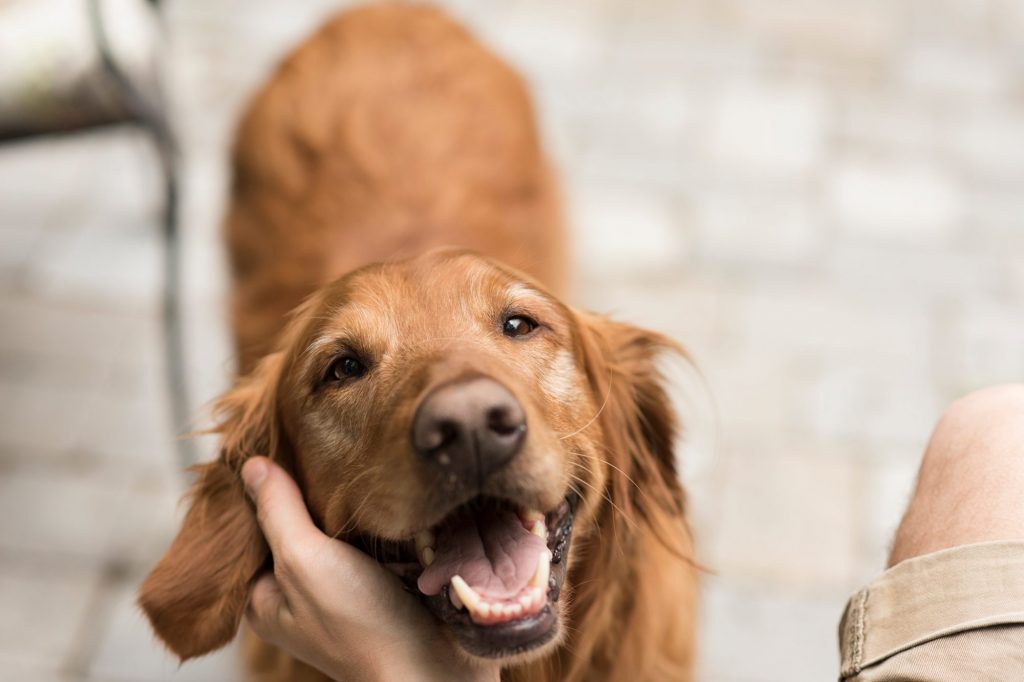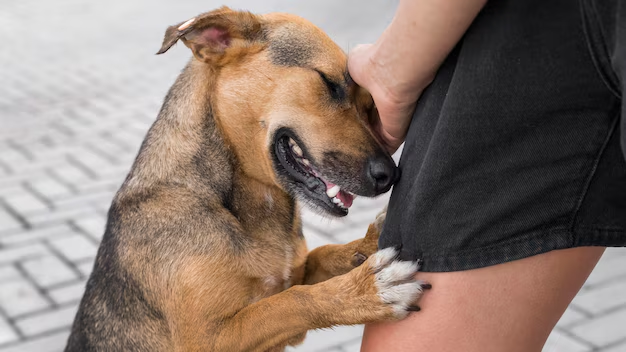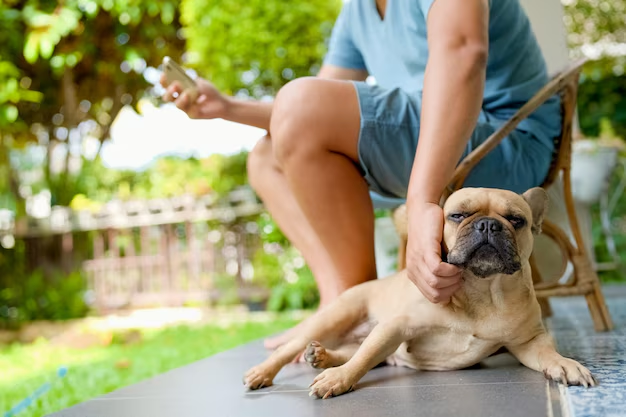Dogs are masters of expressing themselves, and sometimes those expressions can be a little… well, messy! If you’ve ever wondered why your furry friend insists on rubbing their face all over you, you’re not alone. This seemingly strange behaviour can actually have several different meanings.
This guide explores five possible reasons why your dog rubs their face on you, along with tips on how to interpret their actions and respond accordingly.
5 Reasons Why Your Dog Rubs His Face on You
Following are the 5 major reasons your dog rubs his face on you:
1. Scent Marking: Claiming You as Theirs
Dogs have scent glands on their faces, and rubbing their face on you is a way of leaving their scent behind. This is a form of communication, a way of saying, “Hey, this human belongs to me!” It’s a sign of affection and can also be a way of calming themselves down in a new or unfamiliar environment.

Spotting the Signs:
- Your dog rubs their face on you, furniture, or other objects.
- They might also nudge you with their head or lean into you.
How to Respond:
- This behaviour is usually harmless and a sign of affection. If it doesn’t bother you, you can simply continue petting and interacting with your dog.
- However, if you find the face rubbing excessive or inconvenient, you can gently redirect your dog with a toy or a command like “sit.”
Also Read: Heatstroke vs. Heat Exhaustion in Dogs! Learn the Key Difference
2. Seeking Attention: A Playful Nudge
Sometimes, your dog might rub their face on you to get your attention. They might be feeling playful or simply want some love and affection.

Spotting the Signs:
- Your dog rubs their face on you while looking at you expectantly.
- They might also wag their tail, whine, or bark for attention.
How to Respond:
- If you enjoy the face rubs and want to encourage the behaviour, give your dog some attention! Pet them, play with them, or offer them a treat.
- However, if the face rubbing is excessive or unwanted, try ignoring them for a short while. When they calm down and stop rubbing, then offer them some attention and praise the calmer behaviour.
3. Itchy Relief: Scratching Where They Can’t Reach
Dogs can’t exactly scratch their faces with their paws, so sometimes they’ll use you or furniture to get some relief from an itch. This could be due to allergies, fleas, dry skin, or even an ear infection.
Spotting the Signs:
- Your dog rubs their face on you or furniture excessively.
- They might also be scratching other parts of their body with their paws.
- Look for signs of irritation, like redness, flaking skin, or hair loss around the face and ears.

How to Respond:
- If you suspect your dog is itchy due to allergies, fleas, or dry skin, schedule a visit to the vet. They can identify the cause of the itch and recommend appropriate treatment.
- In the meantime, you can help soothe the itch by brushing your dog regularly and using a gentle oatmeal shampoo.
4. Greeting Ritual: A Canine Hello
Just like humans shake hands, some dogs greet their loved ones by rubbing their faces on them. It’s their way of saying hello and showing their excitement to see you.
Spotting the Signs:
- Your dog rubs their face on you when you arrive home or after you’ve been apart for a while.
- They might also wag their tail excitedly and jump up on you (if you allow it!).
How to Respond:
- This is a happy and affectionate behaviour. If it doesn’t bother you, feel free to greet your dog with some pets and praise!
- However, if the face rubbing is accompanied by jumping or excessive energy, you might need to teach your dog a calmer greeting behaviour, like sitting politely for a hello.
5. Calming Mechanism: Self-Soothing with Scents
Believe it or not, some dogs find the act of rubbing their face on something comforting. It might be a way of self-soothing or calming themselves down in a stressful situation.
Spotting the Signs:
- Your dog rubs their face on you or furniture after a stressful experience, like a loud noise or meeting a new person.
- They might also exhibit other signs of anxiety, like pacing, licking their lips, or tucking their tail.

How to Respond:
- If you suspect your dog is rubbing their face due to anxiety, try to identify the source of their stress and remove them from the situation if possible.
- Provide them with a safe space and offer calming reassurance.
- Consider consulting a vet or animal behaviourist for strategies to help manage your dog’s anxiety.
Understanding Your Dog: Beyond the Face Rubs
By understanding the different reasons behind your dog’s face rubbing behaviour, you can respond in a way that addresses their needs and strengthens your bond. Here are some additional tips for deciphering your dog’s communication:
- Body Language: Pay attention to your dog’s overall body language alongside the face rubbing. A wagging tail and relaxed posture indicate a playful or affectionate greeting. However, a tucked tail, flattened ears, or growling might suggest fear or anxiety.
- Context Matters: Consider the situation when the face rubbing occurs. Is it after a walk, upon your arrival home, or during a stressful event? The context can provide valuable clues about your dog’s motivations.
- Know Your Dog: Every dog is an individual. Spend time observing your furry friend and their unique ways of communicating. The more you understand their personality and behaviour, the easier it will be to interpret their actions.
When to See the Vet
While face rubbing is often a harmless behaviour, it’s important to consult your vet if:
- The face rubbing is excessive and seems to be causing irritation or discomfort.
- Your dog is exhibiting other concerning symptoms, like itching, redness, or hair loss around the face and ears.
- You suspect the face rubbing is due to anxiety or stress, and it’s impacting your dog’s well-being.
Building a Stronger Bond with Your Dog
A happy and well-adjusted dog is less likely to display excessive face rubbing or other unwanted behaviours. Here are some ways to strengthen your bond with your canine companion:
- Provide Plenty of Exercise: Regular walks, playtime, and mental stimulation help keep your dog physically and mentally healthy.
- Positive Reinforcement Training: Reward good behaviour with praise, treats, or toys. This encourages desired behaviours and strengthens your communication.
- Quality Time and Affection: Spend quality time with your dog, playing, cuddling, and showering them with love and attention.
- Create a Safe and Secure Environment: Make sure your dog feels safe and secure in their home environment. Provide them with a comfortable bed, familiar toys, and plenty of opportunities to relax.
By understanding your dog’s communication and building a strong bond, you can create a happy and harmonious relationship where face rubs become a cherished expression of love and affection.
Additional Resources for Dog Behaviour
- The Association of Professional Dog Trainers (APDT): https://apdt.com/
- The American Kennel Club (AKC): Dog Training https://www.akc.org/expert-advice/training/operant-conditioning-positive-reinforcement-dog-training/
- The Kennel Club (UK): Dog Training https://www.thekennelclub.org.uk/dog-training/getting-started-in-dog-training/
Remember, a well-trained and well-understood dog is a joy to live with. So, take some time to learn your dog’s language and enjoy the unique ways they communicate their love and devotion!
5 Reasons My Dog Rubs His Face on Me So Much! – FAQs
This FAQ dives deeper into specific questions you might have about your dog’s face-rubbing behaviour:
1. Is it bad if my dog rubs his face on me?
Not necessarily! In most cases, face rubbing is a harmless way for your dog to communicate and interact with you. It can be a sign of affection, a greeting ritual, or a way to claim you as their own.
2. Should I let my dog rub his face on me all the time?
That depends on your personal preference and your dog’s behaviour. If the face rubbing is gentle and doesn’t bother you, there’s no need to discourage it. However, if it’s excessive, inconvenient, or leaves you covered in mud, you can gently redirect your dog with a toy or a command.
3. How can I tell if my dog’s face rubbing is due to itching?
Look for accompanying signs like excessive scratching, redness, or irritation around the face and ears. If your dog is scooting their rear end or seems generally uncomfortable, consult your vet to rule out allergies, fleas, or other skin problems.
4. My dog rubs his face on everything! Is that normal?
Yes, some dogs might rub their face on furniture, objects, and anything else they can reach. This can be a form of scent marking or a way to self-soothe with familiar smells. It’s usually not a concern unless it’s accompanied by destructive behaviour.
5. My dog only rubs his face on me after I come home. What does that mean?
This is likely a happy greeting! Your dog is excited to see you and is using face rubbing as a way to say hello and show their affection.
6. Should I be worried if my dog rubs his face on me when they seem scared?
Not necessarily. Some dogs find the act of rubbing their face on something comforting and familiar. If your dog is scared, face rubbing might be a way of self-soothing. Try to identify the source of their fear and remove them from the situation if possible.
7. How can I stop my dog from jumping up and rubbing their face on me?
Jumping can be an overexcited greeting behaviour. Teach your dog a calmer greeting, like sitting politely. Reward them with praise and treats for the desired behaviour and ignore jumping or face rubbing until they calm down.
8. Is there a way to train my dog not to rub their face on furniture?
You can redirect unwanted behaviours with positive reinforcement training. When your dog starts to rub their face on furniture, offer them a chew toy or redirect their attention with a command and reward them for following your cue.
9. My new puppy rubs their face on everything. Should I be concerned?
Puppies are still learning about the world and how to communicate. Face rubbing can be a way for them to explore their environment and leave their scent behind. Unless it’s accompanied by destructive behaviour, it’s usually nothing to worry about.
10. I’ve tried everything, and my dog still rubs his face on me excessively. What should I do?
If your dog’s face rubbing seems abnormal or is causing you concern, consult your vet. They can rule out any underlying medical conditions and might recommend consulting a professional dog trainer for further guidance on managing the behaviour.
